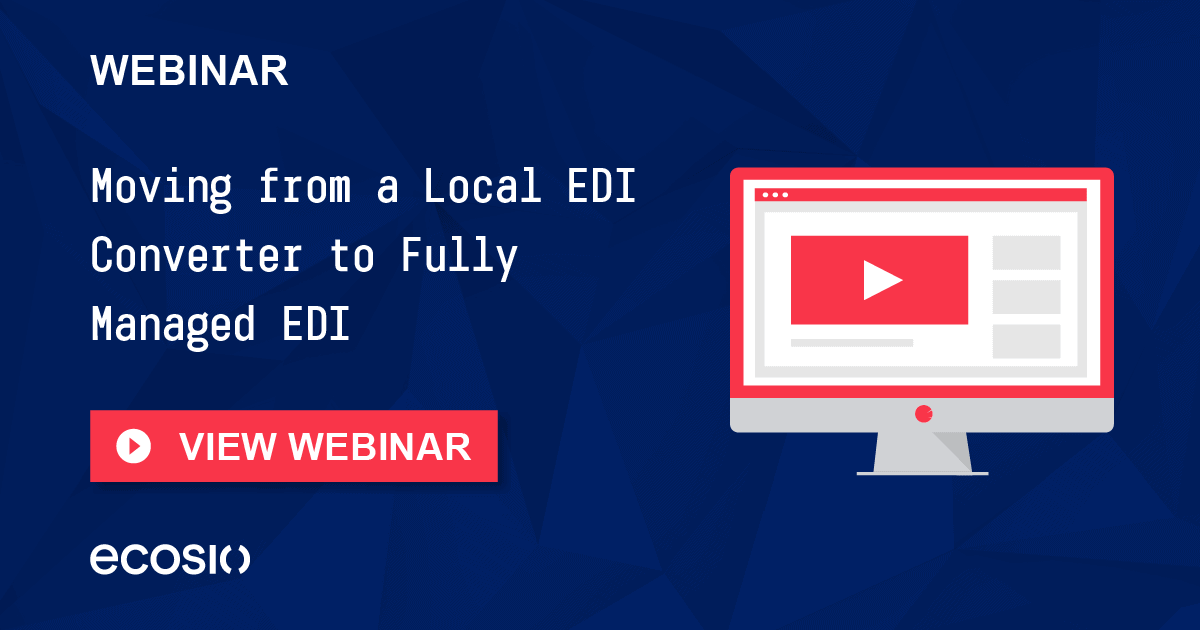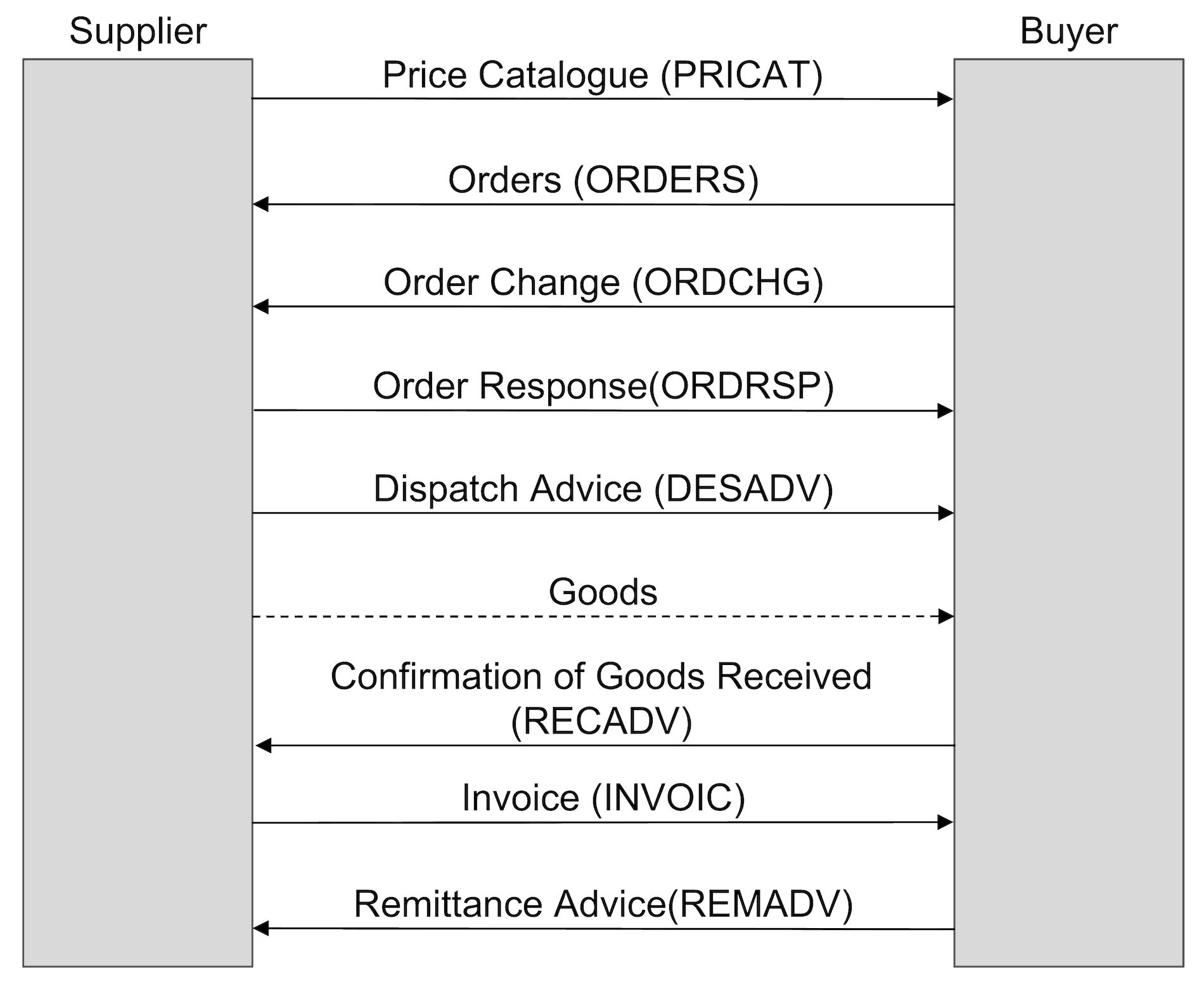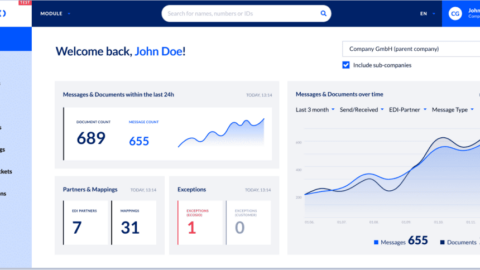EDI document flows between businesses
Through electronic data interchange between companies, structured documents are exchanged between buyers and sellers. These documents are created by ERP systems, and are sent and received automatically.
Businesses such as retail, will exchange different documents between their ERP systems:
- PRICAT: The supplier sends his customer price catalogue data, which he can then save in his ERP system
- ORDERS: The customer sends an order to the supplier
- ORDCHG: The customer changes the placed order
- ORDRSP: The supplier confirms whether he accepts the order or not
- DESADV: The supplier sends a despatch advice to the customer, which contains details about the delivery
- RECADV: The customer confirms the supplier the amount of received goods
- INVOIC: The supplier invoices the delivered goods to the customer
These document types are not necessarily used in every business scenario, and the type and use differ from branch to branch. The last possible document type that can be sent is a REMADV, which we will have a closer look at below.
Learn how fully managed EDI could help to boost your business
REMADV message in the EDI document flow
REMADV (Remittance Advice) is an EDI document, which a company will send to their supplier in order to inform them when and how much they will pay them for the received goods or services.
This allows suppliers to know when exactly they will receive which payment, thus allowing them to better plan and control their financial situation.
In EDIFACT, this document type is REMADV, in ANSI X12 it is an 820 message. The document flow described above would therefore look as follows with an REMADV:
EDI document flow for procurement with REMADV
A remittance advice messages contains various data in regard to the payment of goods. This includes for example the invoice number and amount, surcharge or reduction reasons and amount (e.g., discount), any amount that has already been transferred or is still due, etc. The remittance advice can furthermore refer to different business processes and the corresponding financial transactions.
Here is an example of how a REMADV document can look like in EDIFACT EANCOM D01B format:
UNA:+.? ' UNB+UNOC:3+1234567890123:14+1234567890124:14+190311:1137+00000000004711++REMADV' UNH+1+REMADV:D:01B:UN:EAN004' BGM+481+0024103741+9' DTM+137:20190227113719:204' DTM+203:20190301000000:204' FII+RB+GB32100600003200765324:John Doe Ltd.+SPAODEGFXXX::17' NAD+PR+1234567890125::9' CTA+AD' COM+0044 89 477 23 23:TE' COM+0044 89 477 28 99:FX' COM+0044 89 477 23 28:TE' NAD+SU+1234567890126::9' CUX+2:EUR:11' DOC+380+4365384323' MOA+39:53800.12' MOA+52:1076.00' MOA+12:52724.12' DTM+137:20190213000000:204' UNS+S' MOA+39:53800.12' MOA+12:52724.12' MOA+138:1076.00' UNT+22+1' UNZ+1+00000000004711'
How are businesses benefitting from using REMADV documents?
The information from the REMADV message is automatically imported in the ERP system, which prevents manual interventions. This allows a business to save on internal resources and to reduce the rate of processing errors. It also makes it easier to compare the actual with the target status, so the business can respond accordingly.
A REMADV allows businesses to plan their finances more precisely and in a more reliable way, since their ERP system already has the information about the payments of the invoices before they have reached their accounts. This gives a business the opportunity to create important reports and forecasts, which are needed for the financial planning before the amounts have been paid.
To Sum Up
REMADV is currently hardly used compared to other document types in the EDI world. However, once it has been set up, the advantages are countless. A REMADV is not only helpful when planning your finances, but it also allows you to recognise payment errors early and automatically. Especially large enterprises work with this document type and request its implementation more and more from their business partners.
Do you have any questions?
Do you still have questions about REMADV or about electronic data interchange with an ERP system? Feel free to contact us, we would love to help you!













